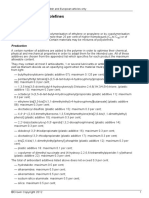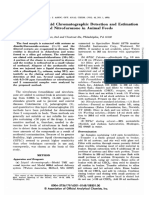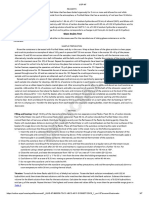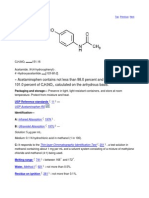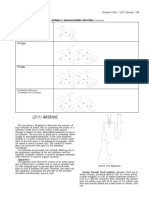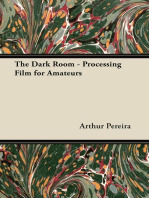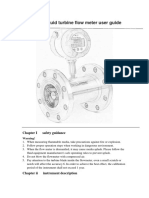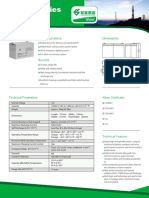0 ratings0% found this document useful (0 votes)
138 views30208E
30208E
Uploaded by
Avinash KumarThis document provides testing procedures to analyze sterile single-use plastic syringes for various quality attributes. It describes tests for ethylene oxide residues using gas chromatography with a flame ionization detector. A calibration curve is prepared using standard solutions of known ethylene oxide concentrations in dimethylacetamide. Additional tests evaluate syringes for clarity, acidity, absorbance, particles, flow rate, pressure resistance, transparency, residue levels, sterility, and pyrogens. The syringe labeling is also specified.
Copyright:
© All Rights Reserved
Available Formats
Download as PDF, TXT or read online from Scribd
30208E
30208E
Uploaded by
Avinash Kumar0 ratings0% found this document useful (0 votes)
138 views3 pagesThis document provides testing procedures to analyze sterile single-use plastic syringes for various quality attributes. It describes tests for ethylene oxide residues using gas chromatography with a flame ionization detector. A calibration curve is prepared using standard solutions of known ethylene oxide concentrations in dimethylacetamide. Additional tests evaluate syringes for clarity, acidity, absorbance, particles, flow rate, pressure resistance, transparency, residue levels, sterility, and pyrogens. The syringe labeling is also specified.
Original Description:
xcvgb
Copyright
© © All Rights Reserved
Available Formats
PDF, TXT or read online from Scribd
Share this document
Did you find this document useful?
Is this content inappropriate?
This document provides testing procedures to analyze sterile single-use plastic syringes for various quality attributes. It describes tests for ethylene oxide residues using gas chromatography with a flame ionization detector. A calibration curve is prepared using standard solutions of known ethylene oxide concentrations in dimethylacetamide. Additional tests evaluate syringes for clarity, acidity, absorbance, particles, flow rate, pressure resistance, transparency, residue levels, sterility, and pyrogens. The syringe labeling is also specified.
Copyright:
© All Rights Reserved
Available Formats
Download as PDF, TXT or read online from Scribd
Download as pdf or txt
0 ratings0% found this document useful (0 votes)
138 views3 pages30208E
30208E
Uploaded by
Avinash KumarThis document provides testing procedures to analyze sterile single-use plastic syringes for various quality attributes. It describes tests for ethylene oxide residues using gas chromatography with a flame ionization detector. A calibration curve is prepared using standard solutions of known ethylene oxide concentrations in dimethylacetamide. Additional tests evaluate syringes for clarity, acidity, absorbance, particles, flow rate, pressure resistance, transparency, residue levels, sterility, and pyrogens. The syringe labeling is also specified.
Copyright:
© All Rights Reserved
Available Formats
Download as PDF, TXT or read online from Scribd
Download as pdf or txt
You are on page 1of 3
EUROPEAN PHARMACOPOEIA 8.0 3.2.8.
Sterile single-use plastic syringes
Carrier gas : helium for chromatography R.
Flow rate: 20 mL/min.
Temperature:
column: 40 C;
injection port : 100 C;
detector: 150 C.
Detection: ame ionisation.
Verify the absence of peaks interfering with the ethylene
oxide peak by carrying out the test using an unsterilised set
or using the same chromatographic system with the following
modications.
Column:
size: l = 3 m, = 3.2 mm;
stationary phase: silanised diatomaceous earth
for gas chromatography R impregnated with
triscyanoethoxypropane R (2 g per 10 g) ;
temperature: 60 C.
Ethylene oxide solution. Prepare in a fume cupboard. Place
50.0 mL of dimethylacetamide R in a 50 mL vial, stopper,
secure the stopper and weigh to the nearest 0.1 mg. Fill a
50 mL polyethylene or polypropylene syringe with gaseous
ethylene oxide R, allow the gas to remain in contact with the
syringe for about 3 min, empty the syringe and ll again with
50 mL of gaseous ethylene oxide R. Fit a hypodermic needle to
the syringe and reduce the volume of gas in the syringe from
50 mL to 25 mL. Inject these 25 mL of ethylene oxide slowly
into the vial, shaking gently and avoiding contact between
the needle and the liquid. Weigh the vial again: the increase
in mass is 45 mg to 60 mg and is used to calculate the exact
concentration of the solution (about 1 g/L).
Test. Weigh the set after removing the package. Cut the set into
pieces of maximum dimension 1 cm and place the pieces in a
250-500 mL vial containing 150 mL of dimethylacetamide R.
Close the vial with a suitable stopper and secure the stopper.
Place the vial in an oven at 70 1 C for 16 h. Remove 1 mL of
the hot gas from the vial and inject it onto the column. From
the calibration curve and the height of the peak obtained,
calculate the mass of ethylene oxide in the vial.
Calibration curve. In a series of 7 vials of the same type
as that used for the test and each containing 150 mL of
dimethylacetamide R, place respectively 0 mL, 0.05 mL,
0.10 mL, 0.20 mL, 0.50 mL, 1.00 mL and 2.00 mL of the
ethylene oxide solution, i.e. about 0 g, 50 g, 100 g, 200 g,
500 g, 1000 g and 2000 g of ethylene oxide. Stopper the
vials, secure the stoppers and place the vials in an oven at
70 1 C for 16 h. Inject 1 mL of the hot gas from each vial
onto the column and draw a calibration curve from the heights
of the peaks and the mass of ethylene oxide in each ask.
Limit : if the label states that ethylene oxide has been used for
sterilisation:
ethylene oxide: maximum 10 ppm.
Extraneous particles. Fill the set via the normal inlet with a
0.1 g/L solution of sodium laurilsulfate R, previously ltered
through a sintered-glass lter (16) (2.1.2) and heated to 37 C.
Collect the liquid via the normal outlet. When examined
under suitable conditions of visibility, the liquid is clear and
practically free from visible particles and laments (it is
assumed that particles and laments with a diameter equal to
or greater than 50 m are visible to the naked eye).
Flow rate. Pass through a complete set with the ow regulator
fully open 50 mL of a solution having a viscosity of 3 mPas
(3 cP) (for example a 33 g/L solution of macrogol 4000 R at
20 C) under a static head of 1 m. The time required for
passage of 50 mL of the solution is not greater than 90 s.
Resistance to pressure. Make tight the extremities of the set
and any air-inlet device. Connect the set to a compressed
air outlet tted with a pressure regulator. Immerse the set in
a tank of water at 20-23 C. Apply progressively an excess
pressure of 100 kPa and maintain for 1 min. No air bubble
escapes from the set.
Transparency. Use as reference suspension the primary
opalescent suspension (2.2.1) diluted 1 in 8 for sets having
tubing with an external diameter less than 5 mm and diluted
1 in 16 for sets having tubing with an external diameter of
5 mm or greater. Circulate the reference suspension through
the set and compare with a set from the same batch lled
with water R. The opalescence and presence of bubbles are
discernible.
Residue on evaporation. Evaporate 50.0 mL of solution S
to dryness on a water-bath and dry to constant mass in an
oven at 100-105 C. Carry out a blank test using 50.0 mL of
water for injections R. The difference between the masses of
the residues is not greater than 1.5 mg.
Sterility (2.6.1). The sets comply with the test for sterility. If
the sets are stated to be sterile only internally, pass 50 mL of
buffered sodium chloride-peptone solution pH 7.0 (2.6.12)
through the set and use to carry out the test by the membrane
ltration method.
If the sets are stated to be sterile both internally and externally,
open the package with the necessary aseptic precautions and:
for the direct inoculation method, place the set or its
components in a suitable container containing a sufcient
quantity of the culture medium to ensure complete
immersion;
for the membrane ltration method, place the set or its
components in a suitable container containing a sufcient
quantity of buffered sodium chloride-peptone solution
pH 7.0 (2.6.12) to allow total rinsing for 10 min.
Pyrogens (2.6.8). Connect together 5 sets and pass through
the assembly at a ow rate not exceeding 10 mL/min 250 mL
of a sterile, pyrogen-free 9 g/L solution of sodium chloride R.
Collect the solution aseptically in a pyrogen-free container.
The solution complies with the test for pyrogens. Inject per
kilogram of the rabbits mass, 10 mL of the solution.
LABELLING
The label states, where applicable, that the set has been
sterilised using ethylene oxide.
01/2008:30208
3.2.8. STERILE SINGLE-USE PLASTIC
SYRINGES
DEFINITION
Sterile single-use plastic syringes are medical devices intended
for immediate use for the administration of injectable
preparations. They are supplied sterile and pyrogen-free
and are not to be re-sterilised or re-used. They consist of a
syringe barrel and a piston which may have an elastomer
sealing ring; they may be tted with a needle which may be
non-detachable. Each syringe is presented with individual
protection for maintaining sterility.
The barrel of the syringe is sufciently transparent to permit
dosages to be read without difculty and allow air bubbles and
foreign particles to be discerned.
The plastics and elastomer materials of which the barrel and
piston are made comply with the appropriate specication
or with the requirements of the competent authority. The
most commonly used materials are polypropylene and
polyethylene. The syringes comply with current standards
regarding dimensions and performance.
Silicone oil (3.1.8) may be applied to the internal wall of the
barrel to assist in the smooth operation of the syringe but there
remains no excess capable of contaminating the contents at
the time of use. The inks, glues and adhesives for the marking
General Notices (1) apply to all monographs and other texts 419
3.2.8. Sterile single-use plastic syringes EUROPEAN PHARMACOPOEIA 8.0
on the syringe or on the package and, where necessary, the
assembly of the syringe and its package, do not migrate across
the walls.
TESTS
Solution S. Prepare the solution in a manner that avoids
contamination by foreign particles. Using a sufcient number
of syringes to produce 50 mL of solution, ll the syringes to
their nominal volume with water for injections R and maintain
at 37 C for 24 h. Combine the contents of the syringes in a
suitable borosilicate-glass container.
Appearance of solution. Solution S is clear (2.2.1) and
colourless (2.2.2, Method II) and is practically free from
foreign solid particles.
Acidity or alkalinity. To 20 mL of solution S add 0.1 mL
of bromothymol blue solution R1. Not more than 0.3 mL
of 0.01 M sodium hydroxide or 0.01 M hydrochloric acid is
required to change the colour of the indicator.
Absorbance (2.2.25) : maximum 0.40, determined between
wavelengths of 220 nm and 360 nm on solution S.
Ethylene oxide. Gas chromatography (2.2.28).
Column:
material : stainless steel ;
size: l = 1.5 m, = 6.4 mm;
stationary phase: silanised diatomaceous earth for gas
chromatography R impregnated with macrogol 1500 R (3 g
per 10 g).
Carrier gas : helium for chromatography R.
Flow rate: 20 mL/min.
Temperature:
Column: 40 C;
Injection port : 100 C;
Detector: 150 C.
Detection: ame ionisation.
Verify the absence of peaks interfering with the ethylene oxide
peak, either by carrying out the test using an unsterilised
syringe or using the same chromatographic system with the
following modications :
Column:
size: l = 3 m, = 3.2 mm;
stationary phase: silanised diatomaceous earth
for gas chromatography R impregnated with
triscyanoethoxypropane R (2 g per 10 g) ;
temperature: 60 C.
Ethylene oxide solution. Prepare in a fume cupboard. Place
50.0 mL of dimethylacetamide R in a 50 mL vial, stopper,
secure the stopper and weigh to the nearest 0.1 mg. Fill a
50 mL polyethylene or polypropylene syringe with gaseous
ethylene oxide R, allow the gas to remain in contact with the
syringe for about 3 min, empty the syringe and ll again with
50 mL of gaseous ethylene oxide R. Fit a hypodermic needle to
the syringe and reduce the volume of gas in the syringe from
50 mL to 25 mL. Inject these 25 mL of ethylene oxide slowly
into the vial, shaking gently and avoiding contact between
the needle and the liquid. Weigh the vial again: the increase
in mass is 45 mg to 60 mg and is used to calculate the exact
concentration of the solution (about 1 g/L).
Calibration curve. In a series of seven vials of the same
type as that used for the test and each containing 150 mL
of dimethylacetamide R, place respectively 0 mL, 0.05 mL,
0.10 mL, 0.20 mL, 0.50 mL, 1.00 mL and 2.00 mL of the
ethylene oxide solution, i.e. about 0 g, 50 g, 100 g, 200 g,
500 g, 1000 g and 2000 g of ethylene oxide. Stopper the
vials, secure the stoppers and place the vials in an oven at
70 1 C for 16 h. Inject 1 mL of the hot gas from each vial
onto the column and draw a calibration curve from the heights
of the peaks and the mass of ethylene oxide in each ask.
Test. Weigh the syringe after removing the package. Cut the
syringe into pieces of maximum dimension 1 cm and place
the pieces in a 250 mL to 500 mL vial containing 150 mL of
dimethylacetamide R. Close the vial with a suitable stopper
and secure the stopper. Place the vial in an oven at 70 1 C
for 16 h. Remove 1 mL of the hot gas from the vial and inject
it onto the column. From the calibration curve and the height
of the peak obtained, calculate the mass of ethylene oxide in
the vial.
Limit : if the label states that ethylene oxide has been used for
sterilisation:
ethylene oxide: maximum 10 ppm.
Silicone oil. Calculate the internal surface area of a syringe in
square centimetres using the following expression:
V = nominal volume of the syringe, in cubic
centimetres;
h = height of the graduation, in centimetres.
Take a sufcient number of syringes to give an internal surface
area of 100 cm
2
to 200 cm
2
. Aspirate into each syringe a
volume of methylene chloride R equal to half the nominal
volume and make up to the nominal volume with air. Rinse
the internal surface corresponding to the nominal volume with
the solvent by inverting the syringe ten times in succession
with the needle tting closed by a nger covered by a plastic
lm inert to methylene chloride. Expel the extracts into a
tared dish and repeat the operation. Evaporate the combined
extracts to dryness on a water-bath. Dry at 100-105 C for
1 h. The residue weighs not more than 0.25 mg per square
centimetre of internal surface area.
Examine the residue by infrared absorption spectrophotometry
(2.2.24). It shows absorption bands typical of silicone oil at
805 cm
1
, 1020 cm
1
, 1095 cm
1
, 1260 cm
1
and 2960 cm
1
.
Reducing substances. To 20.0 mL of solution S add
2 mL of sulfuric acid R and 20.0 mL of 0.002 M potassium
permanganate. Boil for 3 min. Cool immediately. Add 1 g
of potassium iodide R and titrate immediately with 0.01 M
sodium thiosulfate using 0.25 mL of starch solution R as
indicator. Carry out a blank titration using 20.0 mL of water
for injections R. The difference between the titration volumes
is not greater than 3.0 mL.
Transparency. Fill a syringe with water R (blank) and
ll another with a 1 in 10 dilution of primary opalescent
suspension (2.2.1). Use primary opalescent suspension that
has been allowed to stand at 20 2 C for 24 h before use.
Compare with the naked eye in diffused light against a dark
background. The opalescence of the suspension is detectable
when compared with the blank.
Sterility (2.6.1). Syringes stated to be sterile comply with the
test for sterility carried out as follows. Using aseptic technique,
open the package, withdraw the syringe, separate the
components and place each in a suitable container containing
sufcient culture media to cover the part completely. Use both
the recommended media (2.6.1).
Syringes stated to be sterile only internally comply with the test
for sterility carried out as follows. Use 50 mL of inoculation
medium for each test syringe. Using aseptic technique, remove
the needle protector and submerge the needle in the culture
medium. Flush the syringe ve times by withdrawing the
plunger to its fullest extent.
Pyrogens (2.6.8). Syringes with a nominal volume equal to or
greater than 15 mL comply with the test for pyrogens. Fill a
minimum of three syringes to their nominal volume with a
pyrogen-free 9 g/L solution of sodium chloride R and maintain
at a temperature of 37 C for 2 h. Combine the solutions
aseptically in a pyrogen-free container and carry out the test
immediately. Inject per kilogram of the rabbits mass 10 mL of
the solution.
420 See the information section on general monographs (cover pages)
EUROPEAN PHARMACOPOEIA 8.0 3.2.9. Rubber closures for containers
LABELLING
The label on the package states :
the batch number ;
a description of the syringe;
that the syringe is for single-use only.
The label on the outer package states:
the method of sterilisation;
that the syringe is sterile or that it is sterile only internally;
the identity of the manufacturer ;
that the syringe is not to be used if the packaging is
damaged or the sterility protector is loose.
01/2014:30209
3.2.9. RUBBER CLOSURES FOR
CONTAINERS FOR AQUEOUS
PARENTERAL PREPARATIONS,
FOR POWDERS AND FOR
FREEZE-DRIED POWDERS
Rubber closures for containers for aqueous parenteral
preparations, for powders and for freeze-dried powders are
made of materials obtained by vulcanisation (cross-linking),
using appropriate additives, of macromolecular organic
substances (elastomers). The elastomers are produced from
natural or synthetic substances by polymerisation. The choice
of the principal components and of the various additives
(for example, vulcanisers, accelerators, stabilisers, pigments)
depends on the properties required for the nished article.
The specications do not apply to closures made from silicone
elastomer (which are dealt with in chapter 3.1.9. Silicone
elastomer for closures and tubing), to laminated closures or
to lacquered closures.
Rubber closures may be classied in 2 types: type I closures
meet the strictest requirements and are preferred; type II
closures have mechanical properties suitable for special
uses (for example, multiple piercing) and cannot meet
requirements as severe as for type I closures because of their
chemical composition.
The closures chosen for use with a particular preparation are
such that :
the components of the preparation in contact with the
closures are not adsorbed onto the surface of the closures
and do not migrate into or through the closures to an
extent sufcient to affect the preparation adversely;
the closures do not release substances in quantities
sufcient to affect the stability of the preparation or to
present a risk of toxicity.
The closures are compatible with the preparation for which
they are used throughout its period of validity.
The manufacturer of the preparation must obtain from the
supplier an assurance that the composition of the closure
does not vary and that it is identical to that of the closure
used during compatibility testing. If the supplier informs the
manufacturer of the preparation that changes have been made
to the composition, compatibility testing must be repeated,
totally or partly, depending on the nature of the changes.
The closures are washed and may be sterilised before use.
CHARACTERS
Rubber closures are elastic. They are translucent or opaque
and have no characteristic colour, the latter depending
on the additives used. They are practically insoluble in
tetrahydrofuran, in which, however, a considerable reversible
swelling may occur. They are homogeneous and practically
free from ash and adventitious materials (for example, bres,
foreign particles, waste rubber).
Identification of the type of rubber used for the closures is not
within the scope of this specification. The identification tests
given below distinguish between closures made from rubber
and those made from silicone elastomer and plastic materials
but do not differentiate all types of rubber. Other identity
tests may be carried out with the aim of detecting differences
in a batch compared with the closures used for compatibility
testing. One or more of the following analytical methods
may be applied for this purpose: determination of relative
density, determination of sulfated ash, determination of sulfur
content, thin-layer chromatography carried out on an extract,
ultraviolet absorption spectrophotometry of an extract, infrared
absorption spectrophotometry of a pyrolysate or attenuated
total reflectance (ATR).
IDENTIFICATION
A. Infrared absorption spectrophotometry (2.2.24).
Examine by attenuated total reectance (ATR). The
spectrum obtained is identical to the spectrum obtained
with the type sample. If necessary, cut the sample along an
appropriate axis, examine the cut surface and compare the
spectrum with that obtained with the type sample prepared
in the same way.
If direct ATR measurement on the surface is not feasible
(mainly rubber closures lled with carbon black), heat 1-2 g
in a heat-resistant test-tube over an open ame to dry the
sample and continue heating until pyrolysate vapours are
condensed near the top edge of the test-tube. Examine the
pyrolysate of the sample by ATR and compare the spectrum
with that obtained with the pyrolysate of the type sample.
B. Total ash (2.4.16).
Determine the percentage content of total ash in the sample
to be examined and compare with the percentage content
of total ash in the type sample (A
0
). The total ash content
falls within the following ranges depending on the total ash
content of the type sample.
Total ash in the type sample,
A
0
(per cent)
Limit for total ash in the
sample (per cent)
A
0
5.0 (A
0
0.75) to (A
0
+ 0.75)
5.0 < A
0
10 (A
0
1.0) to (A
0
+ 1.0)
A
0
> 10 (A
0
2.0) to (A
0
+ 2.0)
In addition to the use of platinum and silica crucibles
described in general chapter 2.4.16, porcelain crucibles may
be used. The sample may be ignited using a microwave
oven instead of a mufe furnace.
TESTS
The samples to be analysed may be washed and sterilised before
use.
Solution S. Place a number of uncut closures with a total
surface area of about 100 cm
2
in a suitable glass container,
cover with water R, boil for 5 min and rinse 5 times with cold
water R. Place the washed closures in a wide-necked ask
(type I glass, 3.2.1), add 200 mL of water R and weigh. Cover
the mouth of the ask with a borosilicate-glass beaker. Heat
in an autoclave so that a temperature of 121 2 C is reached
within 20-30 min and maintain at this temperature for 30 min.
Cool to room temperature over about 30 min. Make up to
the original mass with water R. Shake and decant the solution
immediately. Shake solution S before each test.
If using a tightly closed ask (type I glass, 3.2.1) with an
inert closure instead of a wide-necked ask covered with a
borosilicate-glass beaker, it is not necessary to make up to the
original mass.
Blank solution. Prepare a blank solution in the same manner
using 200 mL of water R.
General Notices (1) apply to all monographs and other texts 421
You might also like
- Etihad Airways Boarding Pass - TIKVNH - 1Document1 pageEtihad Airways Boarding Pass - TIKVNH - 1Avinash Kumar0% (1)
- 3.2. 3. Sterile Plastic Containers For Human Blood and Blood Components 30203eDocument3 pages3.2. 3. Sterile Plastic Containers For Human Blood and Blood Components 30203esajittNo ratings yet
- Assessment Test - Hope 1Document5 pagesAssessment Test - Hope 1Queenie Gamboa100% (4)
- PH Euro 3.1.3 PolyolefinesDocument9 pagesPH Euro 3.1.3 Polyolefinesryad bmzaNo ratings yet
- PH Eur 2.4.27. Heavy Metals in Herbal Drugs and Fatty OilsDocument2 pagesPH Eur 2.4.27. Heavy Metals in Herbal Drugs and Fatty OilsLuis SanabriaNo ratings yet
- METHOD of ANALYSIS - Allium Cepae ExtractDocument9 pagesMETHOD of ANALYSIS - Allium Cepae ExtractJames AkibonNo ratings yet
- USP 281 ROI Residue On IgnitionDocument2 pagesUSP 281 ROI Residue On IgnitionLisa Debrowski100% (1)
- Wall Wash TestDocument5 pagesWall Wash Testutkarshgahtori100% (1)
- 2.4.18 Free FormaldehydeDocument2 pages2.4.18 Free FormaldehydeMulayam Singh YadavNo ratings yet
- Zif Medical DevicesDocument2 pagesZif Medical DevicesAvinash KumarNo ratings yet
- 3.2.8. Sterile Single-Use Plastic Syringes-2Document2 pages3.2.8. Sterile Single-Use Plastic Syringes-2Avinash Kumar33% (3)
- 3.2. 8. Sterile Single-Use Plastic Syringes 30208eDocument2 pages3.2. 8. Sterile Single-Use Plastic Syringes 30208ec09zxccNo ratings yet
- Appendix XIX G. Sterile Single-Use Plastic SyringesDocument9 pagesAppendix XIX G. Sterile Single-Use Plastic Syringessyed zafar ullah shahNo ratings yet
- PH Euro 3.1.1Document30 pagesPH Euro 3.1.1ryad bmzaNo ratings yet
- Crospovidone PDFDocument2 pagesCrospovidone PDFstselvaNo ratings yet
- Attapulgite From USPDocument2 pagesAttapulgite From USPNofa PuspitaNo ratings yet
- Albumin Solution, HumanDocument3 pagesAlbumin Solution, HumanMulayam Singh Yadav67% (3)
- Oxygen USPDocument2 pagesOxygen USPMartha Lucia Roa FonsecaNo ratings yet
- Furazolidone and Nitrofurazone Dengan HPLCDocument3 pagesFurazolidone and Nitrofurazone Dengan HPLCdewiNo ratings yet
- 10.1.02 AOAC Official Method 985.22 Organochlorine and Organophosphorus Pesticide ResiduesDocument0 pages10.1.02 AOAC Official Method 985.22 Organochlorine and Organophosphorus Pesticide ResiduesTruong Hoai ThanhNo ratings yet
- Arsen.01 ImprimirDocument6 pagesArsen.01 ImprimirLautaro Valentin QuirogaNo ratings yet
- 9.2.27 AOAC Official Method 988.11 Mercury (Methyl) in Fish and ShellfishDocument2 pages9.2.27 AOAC Official Method 988.11 Mercury (Methyl) in Fish and ShellfishLêXuânThắngNo ratings yet
- Water For InjectionsDocument4 pagesWater For InjectionsAlvina Arum PuspitasariNo ratings yet
- USP 660 - 43 - Glass Grain TestDocument2 pagesUSP 660 - 43 - Glass Grain Testamitdi001_667397546No ratings yet
- PegDocument11 pagesPegbbtbadalNo ratings yet
- Rhenium in Catalysts by SpectrophotometryDocument7 pagesRhenium in Catalysts by SpectrophotometryDavinNo ratings yet
- 3.1.5. Polyethylene with addit... - European Pharmacopoeia 11.5 (1)Document4 pages3.1.5. Polyethylene with addit... - European Pharmacopoeia 11.5 (1)Fiona GallagherNo ratings yet
- M976 26 PDFDocument3 pagesM976 26 PDFdanzan1No ratings yet
- 3.1.5. Polyethylene with addit... - European Pharmacopoeia 11.5Document6 pages3.1.5. Polyethylene with addit... - European Pharmacopoeia 11.5Fiona GallagherNo ratings yet
- Usp36-Nf31 01 79Document4 pagesUsp36-Nf31 01 79Salsabil Nurazizah TANo ratings yet
- AcetaminophenDocument3 pagesAcetaminophenJulia BottiniNo ratings yet
- ArsenicDocument3 pagesArsenicjaveria.khalid.waadaNo ratings yet
- Wall Wash Test Procedures On Chemical TankersDocument3 pagesWall Wash Test Procedures On Chemical TankersPavel Viktor100% (1)
- Ethylene Oxide and DioxanDocument2 pagesEthylene Oxide and DioxanMulayam Singh YadavNo ratings yet
- EP-3.3.3Document4 pagesEP-3.3.3Thippani Ramesh VarmaNo ratings yet
- British Pharmacopea - 02 PDFDocument1,345 pagesBritish Pharmacopea - 02 PDFYawanBasopataNo ratings yet
- Testing Method of PP CAPDocument7 pagesTesting Method of PP CAPTaurusVõNo ratings yet
- S946 05 PDFDocument3 pagesS946 05 PDFdanzan1No ratings yet
- Wall Wash ProcedureDocument5 pagesWall Wash ProcedureKamal MuktarNo ratings yet
- USP 601 AEROSOLS, NASAL SPRAYSDocument22 pagesUSP 601 AEROSOLS, NASAL SPRAYSGracia Natalia HerawatiNo ratings yet
- App Moisture 105Document7 pagesApp Moisture 105DanielaGuardiaNo ratings yet
- Oxygen Demand, ChemicalDocument10 pagesOxygen Demand, ChemicalPetrovic NenadNo ratings yet
- 1847 eDocument3 pages1847 eMiroslav IlicNo ratings yet
- Total Dissolved Solids ProcedureDocument13 pagesTotal Dissolved Solids Procedurehemavathi jayNo ratings yet
- Oxygen (Oxygenium) : The International Pharmacopoeia - Tenth Edition, 2020Document5 pagesOxygen (Oxygenium) : The International Pharmacopoeia - Tenth Edition, 2020Passmore DubeNo ratings yet
- Appendix B - Analytical MethodsDocument9 pagesAppendix B - Analytical MethodsRebecca SchroederNo ratings yet
- Jecfa Co2 2006Document4 pagesJecfa Co2 2006Stella Lupita June TjandraNo ratings yet
- Pharmaceutical CGMP Guidelines Water TestingDocument24 pagesPharmaceutical CGMP Guidelines Water TestingloisetapiceriaNo ratings yet
- Xanthani GummiDocument2 pagesXanthani GummiLaurentiu DinuNo ratings yet
- Hydrogen Cyanide Estimation in SorghumDocument5 pagesHydrogen Cyanide Estimation in SorghumdsatyNo ratings yet
- 6015 RevDocument7 pages6015 RevAdem YildirimNo ratings yet
- 2.4.13 SulfatesDocument1 page2.4.13 SulfatesMulayam Singh YadavNo ratings yet
- MOADocument6 pagesMOAjosewarametalNo ratings yet
- Wall Wash TestDocument5 pagesWall Wash TestutkarshgahtoriNo ratings yet
- 3.1.1. 1. Materials Based On Plasticised Polyvinyl Chloride For Containers For Human Blood and Blood Components 90001eDocument4 pages3.1.1. 1. Materials Based On Plasticised Polyvinyl Chloride For Containers For Human Blood and Blood Components 90001eOscar LoretoNo ratings yet
- Elisa HistaminaDocument10 pagesElisa HistaminaLilia VERASNo ratings yet
- DR 4000 Silica Method 8282Document8 pagesDR 4000 Silica Method 8282tuankiet31No ratings yet
- Usp36-Nf31 01 38Document2 pagesUsp36-Nf31 01 38Salsabil Nurazizah TANo ratings yet
- Advanced Pharmaceutical analysisFrom EverandAdvanced Pharmaceutical analysisRating: 4.5 out of 5 stars4.5/5 (2)
- Standard methods for the examination of water and sewageFrom EverandStandard methods for the examination of water and sewageNo ratings yet
- The Chemistry of Fertilisers and Manure - Including Information on the Chemical Constituents and Types of Fertilisers and ManuresFrom EverandThe Chemistry of Fertilisers and Manure - Including Information on the Chemical Constituents and Types of Fertilisers and ManuresRating: 5 out of 5 stars5/5 (1)
- Contemporary Anaesthetic Equipments.: An Aid for Healthcare ProfessionalsFrom EverandContemporary Anaesthetic Equipments.: An Aid for Healthcare ProfessionalsNo ratings yet
- Annex 1Document1 pageAnnex 1Avinash KumarNo ratings yet
- Ips Bihar CadreDocument5 pagesIps Bihar CadreAvinash Kumar100% (1)
- Hindustan Times E-Paper - Hindustan Patna (Hindi) - 2 Jun 2014 - Page #4Document2 pagesHindustan Times E-Paper - Hindustan Patna (Hindi) - 2 Jun 2014 - Page #4Avinash KumarNo ratings yet
- Mr. Arun Kumar Singh Is The Director of The Company and Responsible For Accelerating GrowthDocument1 pageMr. Arun Kumar Singh Is The Director of The Company and Responsible For Accelerating GrowthAvinash KumarNo ratings yet
- 1st Mar'14Document1 page1st Mar'14Avinash KumarNo ratings yet
- COMMUNITY HEALTH NSC 322 LectureDocument52 pagesCOMMUNITY HEALTH NSC 322 LectureChinenye LovethNo ratings yet
- Baroque Period ArtsDocument60 pagesBaroque Period ArtsAngelo Rodriguez100% (1)
- AASHTO Steel Bridge Design Handbook Volume 10Document18 pagesAASHTO Steel Bridge Design Handbook Volume 10walaywan0% (1)
- Anticipation: Basic 3D Animation Using BlenderDocument15 pagesAnticipation: Basic 3D Animation Using BlenderAnnie VoinovaNo ratings yet
- WWW - Wwewirerope.com Wirerope PDFDocument5 pagesWWW - Wwewirerope.com Wirerope PDFboyzesNo ratings yet
- GT-Turbine Flowmeter ManualDocument16 pagesGT-Turbine Flowmeter Manualedgarcoo100% (1)
- Organelle Trading Card GamealpsDocument1 pageOrganelle Trading Card GamealpschabriesNo ratings yet
- 10-Correlation and Linear RegressionDocument25 pages10-Correlation and Linear RegressionKarazayNo ratings yet
- Clustering For Model Reduction of Circuits: Multi-Level TechniquesDocument43 pagesClustering For Model Reduction of Circuits: Multi-Level TechniquesMilind RavindranathNo ratings yet
- Aircraft Flight Control SystemDocument5 pagesAircraft Flight Control SystemVS KRISHNA KUMARNo ratings yet
- Categories of Hardware Tools and Its UsesDocument3 pagesCategories of Hardware Tools and Its UsesJessie James Bendicio VirtuosoNo ratings yet
- Deep Feedforward Networks and Regularization: Licheng ZhangDocument56 pagesDeep Feedforward Networks and Regularization: Licheng Zhang18MDS019No ratings yet
- Adverse Pressure Gradient: See AlsoDocument1 pageAdverse Pressure Gradient: See AlsoLijukrishnanNo ratings yet
- Midori Plains Subdivision Tungkop Minglanilla CebuDocument34 pagesMidori Plains Subdivision Tungkop Minglanilla CebucebudotcomNo ratings yet
- List of Formula For Unit-3 and Unit-4Document7 pagesList of Formula For Unit-3 and Unit-4Hitika TeckaniNo ratings yet
- Silently Recite A Prayer For The Success of The Procedure. To Ensure That The Procedure Will Be Done Smoothly Without ErrorDocument11 pagesSilently Recite A Prayer For The Success of The Procedure. To Ensure That The Procedure Will Be Done Smoothly Without ErrorJemina Rafanan RacadioNo ratings yet
- (E12) - Đề luyện tập số 1 (2025)Document5 pages(E12) - Đề luyện tập số 1 (2025)Lan HuongNo ratings yet
- 6 GFM 100 (Shoto)Document2 pages6 GFM 100 (Shoto)Hoàng Hà NguyễnNo ratings yet
- Chapter 23Document53 pagesChapter 23haririNo ratings yet
- The Tuffest Stuff CT Registry Review Seminar Solution: Episode 6Document32 pagesThe Tuffest Stuff CT Registry Review Seminar Solution: Episode 6Areej AwadNo ratings yet
- Vie Pc01 STN DWG MP Ppa 01107 0Document1 pageVie Pc01 STN DWG MP Ppa 01107 0Ashish BhartiNo ratings yet
- Climatic and Vegetation Zones Table To ReferDocument3 pagesClimatic and Vegetation Zones Table To Referhsk12No ratings yet
- Dialogue of Self & SoulDocument6 pagesDialogue of Self & Soulm14058103No ratings yet
- Personal Monthly BudgetDocument3 pagesPersonal Monthly Budgetbeni471No ratings yet
- EJM - Volume 53 - Issue 1 - Pages 49-68Document20 pagesEJM - Volume 53 - Issue 1 - Pages 49-68seema yadavNo ratings yet
- Group 3 - Robot Hotel Report - Ads557 - N4am2284dDocument21 pagesGroup 3 - Robot Hotel Report - Ads557 - N4am2284dNURUL INSYIRAH AHMAD TAJODINNo ratings yet
- TdsDocument2 pagesTdsyaswanth reddy mummadiNo ratings yet
- MACHINING NC I (Superseded)Document73 pagesMACHINING NC I (Superseded)zaidoNo ratings yet
- Determination of Permeability of Soil by Falling Head MethodDocument3 pagesDetermination of Permeability of Soil by Falling Head MethodB S Praveen BspNo ratings yet



